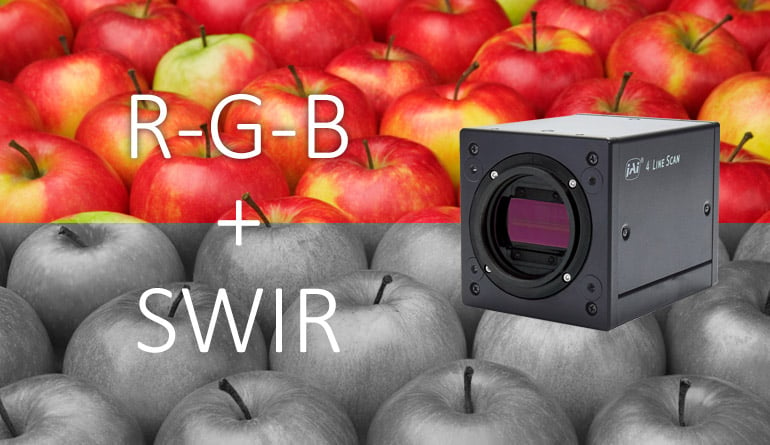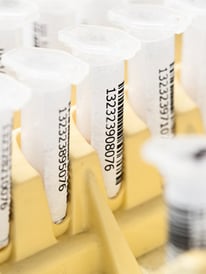
JAI announces a new industrial prism-based line scan camera. The new camera model (SW-4010Q-MCL) features 4-sensor line scan technology that allows for simultaneous collection of red, green and blue image data on three separate CMOS sensors plus a fourth sensor that collects image data from the short wave infrared (SWIR) spectrum using a sensor based on indium gallium arsenide (InGaAs) technology.
The new SW-4010Q-MCL model joins JAI´s existing Sweep+ Series of 3-CMOS R-G-B and 4-CMOS R-G-B-NIR line scan cameras thereby expanding multispectral imaging to the SWIR electromagnetic waveband.
Just like with JAI’s 4-CMOS R-G-B-NIR cameras, the infrared channel can disclose “hidden” image data that is not observable in the visible light range.
But as SWIR light has a different physical behavior in relation to light absorption, transmission, and reflection than NIR light (when interacting with objects), it presents new opportunities for collecting image data from beneath the surface of objects, enabling disclosure of hidden and unwanted defects on the items being inspected.

The Sweep+ 4-sensor camera advantage:
In machine vision systems where there is a requirement for imaging using both visible and SWIR light to ensure required quality levels, the SW-4010Q-MCL camera delivers visible/SWIR images in a single inspection routine.
Combining CMOS and InGaAs image sensors in the same industrial camera makes it possible to perform advanced color inspection collecting visible light data (from 400 ~ 700 nm) via the three CMOS sensors, while at the same time obtaining image data via the fourth InGaAs sensor from light waves in the 800 nm ~ 1700 nm range.
The result is lower setup complexity and lower hardware costs in machine vision systems where inspection is needed in both the visible and SWIR light range. Thus, SWIR imaging can provide even better machine vision inspection efficiency for a range of applications.
Each of the three CMOS line sensors has a resolution of 4096 pixels, a pixel size of 7.5 µm x 7.5 µm, a sensor width of 30.72 mm, and a maximum scan rate of 20.6 kHz in full resolution. In comparison, the InGaAs line sensor provides a resolution of 1024 pixels, 25 µm square pixels, a sensor width of 25.6 mm, and a full resolution scan rate of 39 kHz.
A special Xscale function can be applied to harmonize the field-of-view (FOV) and scan rates between the two sensor types:
If the vision designer’s aim is to have the same field-of-view (FOV) of the two sensor types, the camera features a special version of JAI’s pixel rescaling function (Xscale) which can manually or automatically adjust the “virtual” pixel size of the R-G-B sensors. Used in combination with manual or automatic ROI adjustments, it is then possible to obtain the same sensor width and scan rate of the two different sensor types.
More useful functions to improve your machine vision systems:
The SW-4010Q-MCL has a built-in color conversion function that allows the color output to be provided in HSI or CIE XYZ color format if needed, as well as offering conversions from standard RGB to the sRGB or Adobe RGB color spaces, or even to a user-defined custom RGB conversion matrix. Other features include individual gain and shutter control for each of the four channels, dual-stream data output (RGB and SWIR in separate data streams), trigger and encoder control, and noise reduction filters, to name a few.
Special lens to handle both visible and SWIR light:
JAI also provides a special lens (sold separately) that is optimized to handle both visible and SWIR light. The camera is equipped with a dual Mini Camera Link interface and an M52 lens mount.
In what applications can the new JAI 4-sensor R-G-B-SWIR camera prove valuable?
 |
Fruit, vegetable, and nut inspection:
|
|
Semiconductor inspection: |
 |
Pharmaceutical inspection: In pharmaceutical inspection applications, the camera can, for example, inspect the finished package on the outside (looking at the color printing and package completeness) while at the same time looking through opaque plastic packages and containers to check for correct amount of content or fill levels of liquids or powder. |
| Battery inspection: Flawless batteries are critical for safety, energy density and to prevent early degradation. JAI’s Line scan cameras can be used to check for defects such as scratches, dents, craters, bubbles, inclusions, and holes on electrode sheets. |
 |
More applications:
Other applications include various web inspection in connection with manufacturing of items such as color tiles and textiles (checking if dyed textile is dry enough for further processing. The camera can also prove useful in waste sorting of different plastic types, mineral sorting, and agriculture/forestry applications.


